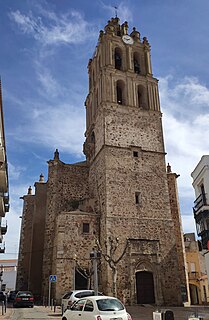
Almendralejo is a town in the Province of Badajoz, Extremadura, Spain. It is situated 45 km south-east of Badajoz, on the main road and rail route between Mérida and Seville. As of 2010, it has a population of 33,975. It was the site of a battle and massacre in 1936 during the Spanish Civil War.

Club Deportivo Badajoz is a Spanish football team based in Badajoz, in the autonomous community of Extremadura. Founded in 1905 and refounded in 2012, it currently plays in Primera División RFEF – Group 1, and holds home games at Estadio Nuevo Vivero, with a 15,198-seat capacity.

Club de Fútbol Extremadura was a Spanish football team based in Almendralejo, in the autonomous community of Extremadura. Founded in 1924, it played two seasons in La Liga, and held home games at Estadio Francisco de la Hera, with a capacity of 11,580 seats. The club folded in 2010 following several years of financial problems.

Estadio Helmántico is a football stadium in Salamanca, Spain where UD Salamanca played home matches, and is the home stadium of Salamanca CF UDS. The stadium holds 17,341 and was built in 1970. It is located in the municipality of Villares de la Reina, on the outskirts of the city.

Salamanca Club de Fútbol UDS, previously known as CF Salmantino, is a Spanish football team based in Salamanca, in the autonomous community of Castile and León. Founded in 2013 after the dissolution of UD Salamanca, it currently plays in Segunda División RFEF – Group 1, holding home games at the Estadio Helmántico with a 17,341-seat capacity.

Extremadura Unión Deportiva was a Spanish football team based in Almendralejo, in the autonomous community of Extremadura. Founded in 2007, it last played in Primera División RFEF – Group 1, holding home games at Estadio Francisco de la Hera.

Extremadura Unión Deportiva Femenino, formerly known as CF Puebla Extremadura and later as Extremadura Femenino CF, is a Spanish women football club from Almendralejo.
Juan Sabas Huertas Lorente is a Spanish former footballer who played as a forward, currently a manager.
Extremadura Unión Deportiva "B" is the reserve team of Extremadura UD, a Spanish football club based in Almendralejo, in the autonomous community of Extremadura. Founded in 1986 as Atlético San José Promesas it last played in Tercera División RFEF - Group 14, holding home games at Estadio Tomás de la Hera, with a 3,000-seat capacity.
The 2013–14 Copa Federación de España was the 21st staging of the Copa Federación de España, also known as Copa RFEF, a knockout competition for Spanish football clubs in Segunda División B and Tercera División. The Copa Federación winner got the trophy and a cash prize of 90,152 euros. It also qualified for the next edition of the tournament. The runner-up received a prize of 30,051 euros and each semifinalist 12,020 euros.

Unionistas de Salamanca Club de Fútbol is a Spanish football club in Salamanca, in the autonomous community of Castile and León. Founded in 2013, the club plays in Primera División RFEF – Group 1, holding home games at Campo de Fútbol Reina Sofía with a 5,000-seat capacity.
The 2018–19 Segunda División season, also known as LaLiga 1|2|3 for sponsorship reasons, was the 88th season of the Spanish football second division since its establishment.
The 2019–20 Segunda División season, also known as LaLiga SmartBank for sponsorship reasons, was the 89th since its establishment.
Samuel González Martínez, known as Samu Manchón, is a Spanish professional footballer who plays for UD Montijo. Mainly an attacking midfielder, he can also play as a winger or a right back.
Enric Gallego Puigsech is a Spanish professional footballer who plays as a striker for CD Tenerife.
The 2020–21 Segunda División B season was the 44th since its establishment and the last as the third tier. A total of 102 teams participated, and were distributed in three groups of 20 teams each and two groups of 21, with eight subgroups of ten teams each and two with eleven teams each.
The 2021–22 Primera División RFEF season is the first for the Primera División RFEF, the new third highest level in the Spanish football league system. It succeeded the old Segunda División B, which renamed itself Segunda División RFEF and downgraded to the fourth level in the pyramid. Forty teams will participate, divided into two groups of twenty clubs each based on geographical proximity. In each group, the champions automatically promoted to Segunda División and the second to fifth placers will play promotion play-offs and the bottom five are relegated to the Segunda División RFEF.
The 2022–23 Primera División RFEF season will be the second for the Primera División RFEF, the new third highest level in the Spanish football league system. Forty teams will participate, divided into two groups of twenty clubs each based on geographical proximity. In each group, the champions automatically promoted to Segunda División and the second to fifth placers will play promotion play-offs and the bottom five are relegated to the Segunda División RFEF.
The 2022–23 Segunda División RFEF season will be the second for the Segunda División RFEF, the new fourth highest level in the Spanish football league system. Ninety teams will participate, divided into five groups of eighteen clubs each based on geographical proximity. In each group, the champions automatically promoted to Primera División RFEF, and the second to fifth placers will play promotion play-offs. The last five teams in each group will be relegated to the Tercera División RFEF; in addition, the four worst teams classified 13th in their group will play play-offs to define the last two relegation places.








